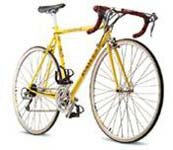When sizing for proper position, don't worry about frame or stem dimensions. That comes next ... The way you feel on the bike is infinitely more important than the way the bike looks. Which is another way of saying that if you already own the bike you plan on keeping for a while, don't worry if your stem looks too short, or too high, or if your seat is pushed way forward, etc... the most important thing is that you will be more efficient and have more enjoyment when your biomechanic position is correct.
 1. Ankling. There has been significant debate about the correct angle of the foot as it moves about the pedal stroke. Toe down, heel down or foot flat ... there have been highly successful professional espousing each extreme and everything in between. We are convinced that the angle of your foot is like your gait when you walk. It belongs to you, and is something that develops naturally. Don't worry about copying someone else.
1. Ankling. There has been significant debate about the correct angle of the foot as it moves about the pedal stroke. Toe down, heel down or foot flat ... there have been highly successful professional espousing each extreme and everything in between. We are convinced that the angle of your foot is like your gait when you walk. It belongs to you, and is something that develops naturally. Don't worry about copying someone else.
2. Where to drop the plum line from your knee. There are two points used to drop the line. The base of the tibia tuberosity (where the protrusion below your kneecap disappears into your shin bone) is the more commonly used location. When possible we prefer to find the soft hollow just behind the kneecap (on the outside of the leg). This is more of an indicator of the true function of the knee joint.
3. Back posture is a problem for many people, cyclists and non-cyclists alike. Cyclists sometimes have poor back posture (on the bike) because they have been riding poor fitting bicycles for too long. Or sometimes they adopt poor posture on the bike because they already have poor posture, perhaps from sitting bent over at a desk all day, or just because they never paid attention. Ideally your back posture should be almost straight ... when standing your lower back should be slightly concave in the lumbar area. If you have difficulty straightening your back, do not force a major change suddenly, as you may cause as much damage and pain as you may avoid. This is because your muscles have developed in support of this position and are not accustomed to being elongated.
The best cure for this is stretching ... improving your flexibility. If you have a real problem, yoga can work wonders. If you are buying a new bike, and you feel you need to correct your back posture, buy the frame to fit optimally with your elongated position, but outfit initially with a shorter stem and then as you gain flexibility, change to a longer stem.
A Serotta Size-Cycle and appropriately trained technician is available in the form of James Huggins, of Rock 'n' Road Cycles. If you like what you hear in this section please with your details and we will be happy to pass them on to James. James also imports the complete range of Serotta bikes from the USA so again if you are interested in further details and we'll do the necessary.